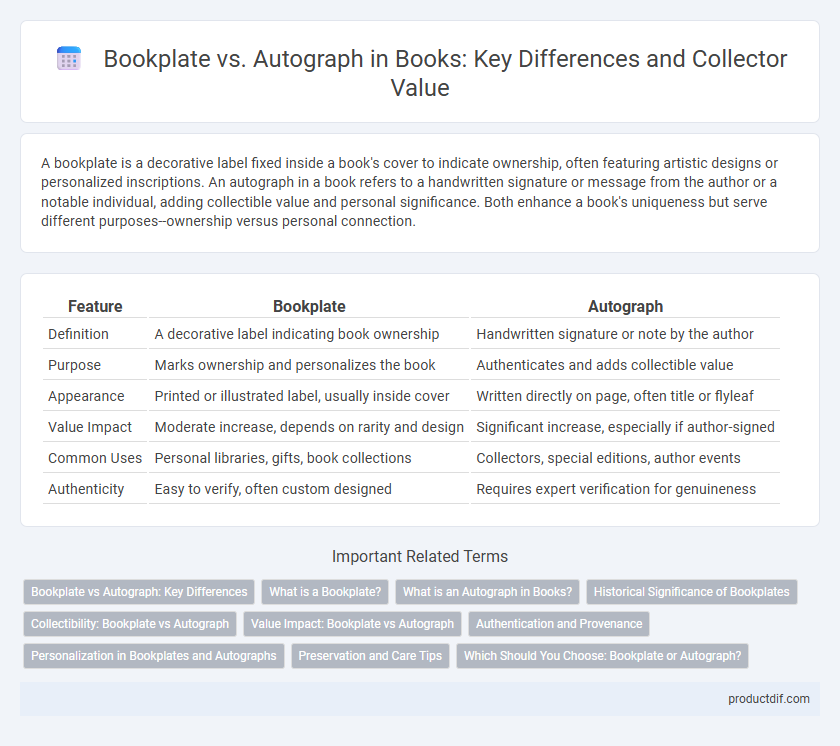A bookplate is a decorative label fixed inside a book's cover to indicate ownership, often featuring artistic designs or personalized inscriptions. An autograph in a book refers to a handwritten signature or message from the author or a notable individual, adding collectible value and personal significance. Both enhance a book's uniqueness but serve different purposes--ownership versus personal connection.
Table of Comparison
| Feature | Bookplate | Autograph |
|---|---|---|
| Definition | A decorative label indicating book ownership | Handwritten signature or note by the author |
| Purpose | Marks ownership and personalizes the book | Authenticates and adds collectible value |
| Appearance | Printed or illustrated label, usually inside cover | Written directly on page, often title or flyleaf |
| Value Impact | Moderate increase, depends on rarity and design | Significant increase, especially if author-signed |
| Common Uses | Personal libraries, gifts, book collections | Collectors, special editions, author events |
| Authenticity | Easy to verify, often custom designed | Requires expert verification for genuineness |
Bookplate vs Autograph: Key Differences
Bookplates are decorative labels affixed inside a book to indicate ownership, often featuring intricate designs and personalized motifs, whereas autographs consist of handwritten signatures or inscriptions by authors or notable individuals. The primary distinction lies in their purpose; bookplates serve as a visual ownership mark, while autographs add unique historical and sentimental value to the specific copy of the book. Collectors often seek autographs for authenticity and provenance, while bookplates appeal to those interested in the artistic and ownership aspects of rare books.
What is a Bookplate?
A bookplate, also known as an ex-libris, is a decorative label affixed inside the front cover of a book to indicate ownership, often featuring the owner's name, initials, or a personalized design. Unlike autographs, which are handwritten signatures or inscriptions by the author or a notable person, bookplates serve primarily as a durable and artistic mark of the book's belonging. Collectors and bibliophiles value bookplates for their historical significance and their role in tracing provenance.
What is an Autograph in Books?
An autograph in books refers to a handwritten signature or inscription by the author, often adding personal value and authenticity to the volume. Unlike a bookplate, which is a printed label indicating ownership, an autograph is unique and directly connects the reader to the author's presence. Collectors highly seek autographed books for their rarity and historical significance.
Historical Significance of Bookplates
Bookplates, often intricately designed and bearing personal or family insignia, date back to the 15th century and served as early forms of book ownership identification, reflecting social status and cultural heritage. Unlike autographs, which are signatures of authors or notable individuals added to books, bookplates provide a visual representation of provenance and were historically used to prevent theft and assert intellectual property. Collectors and historians value bookplates for their artistic merit and as tangible links to the history of book collecting and ownership practices.
Collectibility: Bookplate vs Autograph
Bookplates offer a unique collectible appeal through their artistic designs, heraldic emblems, and personalized ownership marks, often reflecting historical book ownership and provenance. Autographs enhance collectibility by providing direct personal connections to authors or notable figures, significantly increasing the book's sentimental and monetary value. Collectors prioritize autographs for rarity and authenticity, while bookplates attract those interested in book history and visual artistry.
Value Impact: Bookplate vs Autograph
Autographs typically hold greater value than bookplates due to their direct personal connection to the author, enhancing the book's uniqueness and collectible appeal. Bookplates, often decorative labels indicating ownership, contribute to provenance but rarely increase a book's market value significantly. Collectors prioritize autographs as rare, authentic marks, making them more impactful on a book's worth compared to standard bookplates.
Authentication and Provenance
A bookplate serves as a printed or decorative label indicating ownership, aiding provenance by tracing the book's history through identifiable marks. An autograph, often a handwritten signature or inscription by the author or notable owner, provides a unique form of authentication that can verify the book's origin or past ownership. Together, bookplates and autographs enhance a book's provenance by offering tangible evidence of authenticity and ownership lineage.
Personalization in Bookplates and Autographs
Bookplates and autographs both serve as forms of personalization in books, but they differ in their approach and intent. Bookplates are decorative labels affixed inside a book, often featuring the owner's name, motto, or artwork, establishing a permanent visual identity for the book's provenance. Autographs, on the other hand, consist of the author's handwritten signature or personal inscription, adding unique sentimental and collectible value through direct authorial connection.
Preservation and Care Tips
Bookplates, designed to identify ownership, require careful placement on the inside cover to avoid damaging pages, while autographs, often signed on title pages or flyleaves, benefit from protective sleeves or archival-quality materials to prevent fading and smudging. To preserve both bookplates and autographs, maintain stable humidity and temperature, avoid direct sunlight, and handle with clean hands or cotton gloves. Using acid-free paper inserts and storing books upright on shelves further protects these memorabilia from deterioration and physical wear.
Which Should You Choose: Bookplate or Autograph?
Choosing between a bookplate and an autograph depends on your collecting goals and the book's value. Bookplates offer a decorative, personalized touch and establish ownership, enhancing the book's aesthetic appeal without altering the original pages. Autographs, especially from authors, provide unique provenance and can significantly increase a book's monetary and sentimental worth, making them ideal for collectors seeking rarity and authenticity.
Bookplate vs Autograph Infographic

 productdif.com
productdif.com